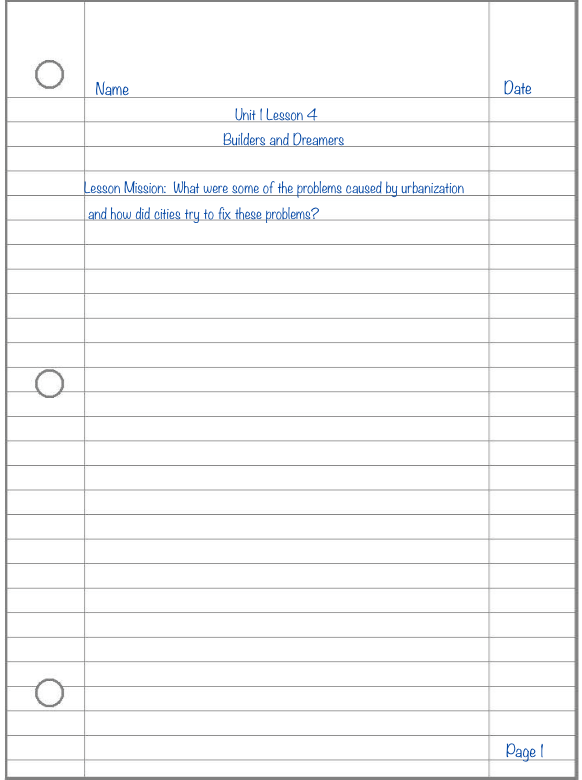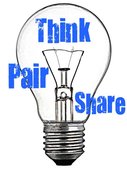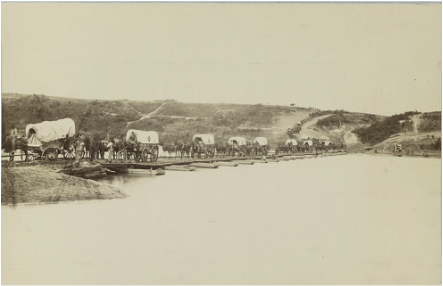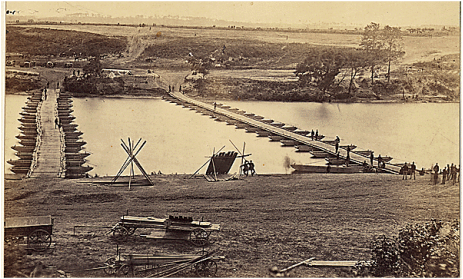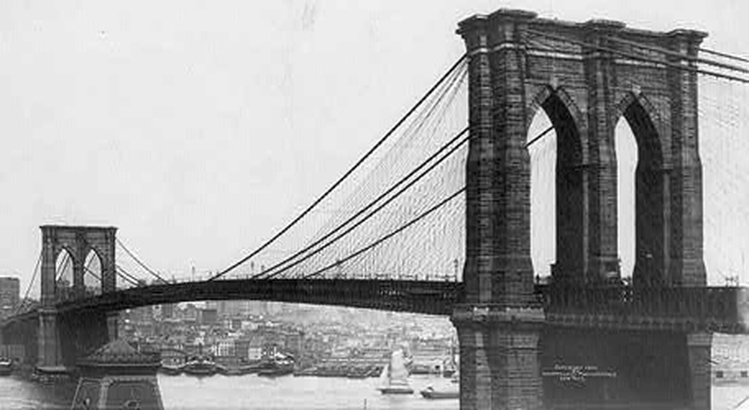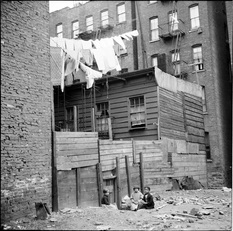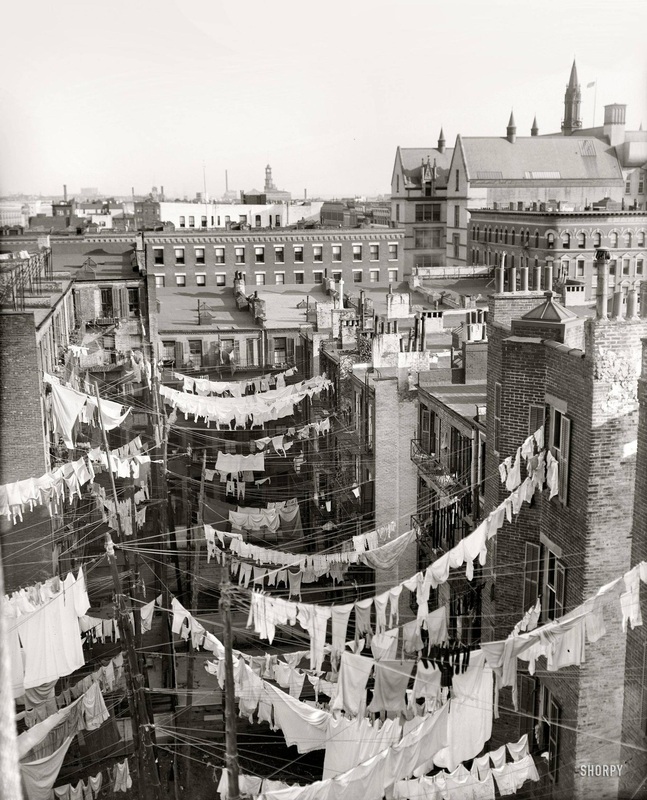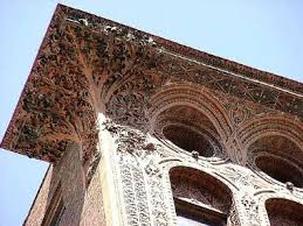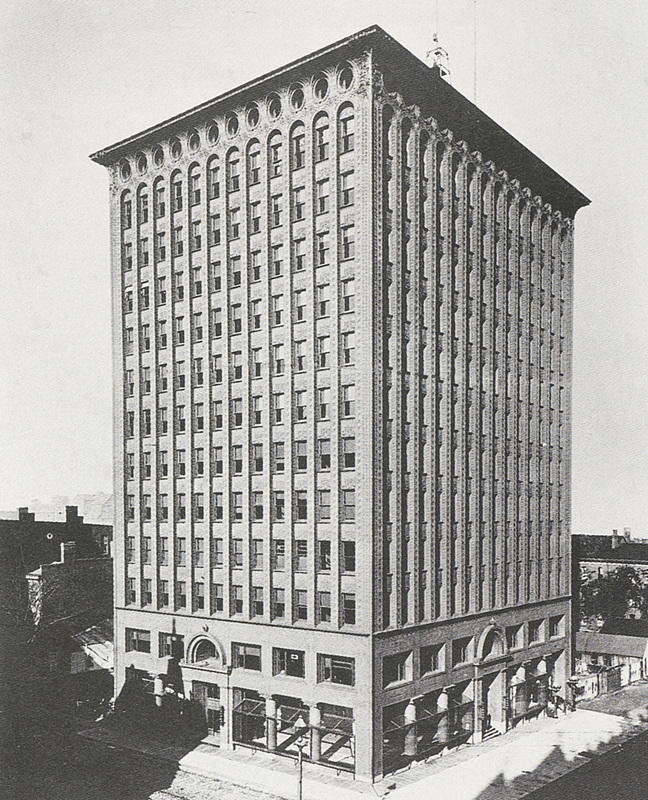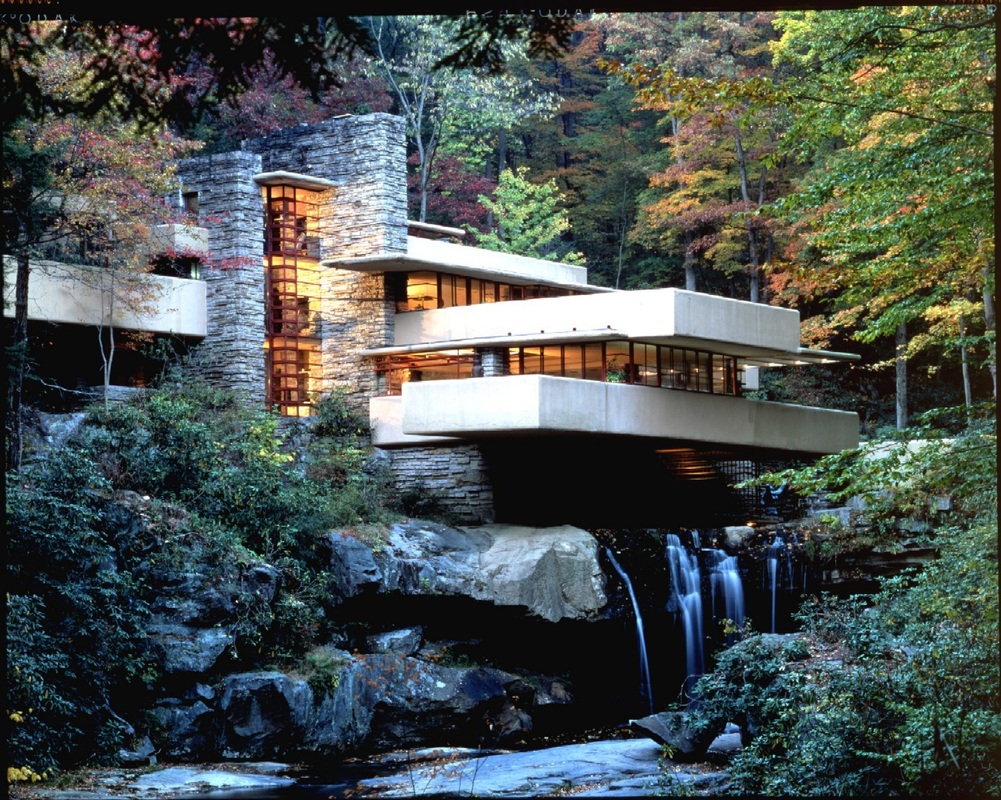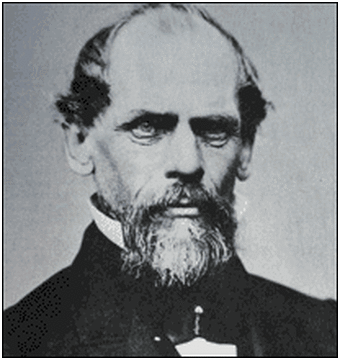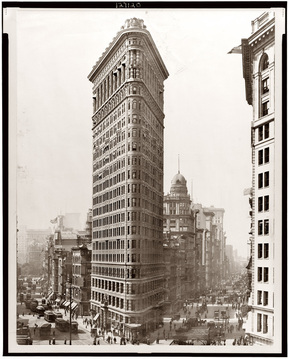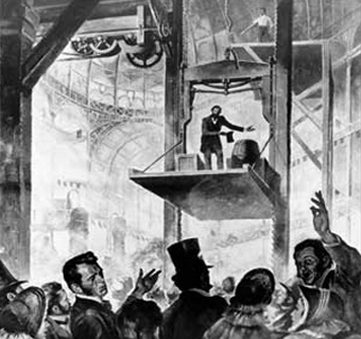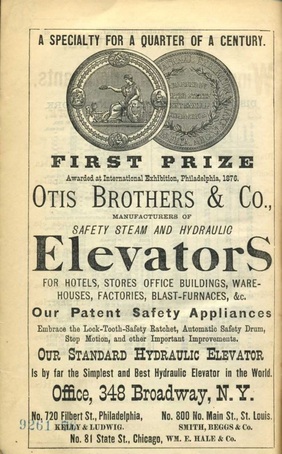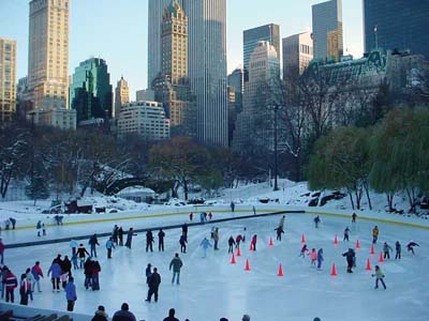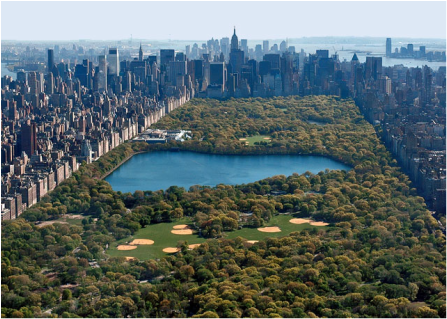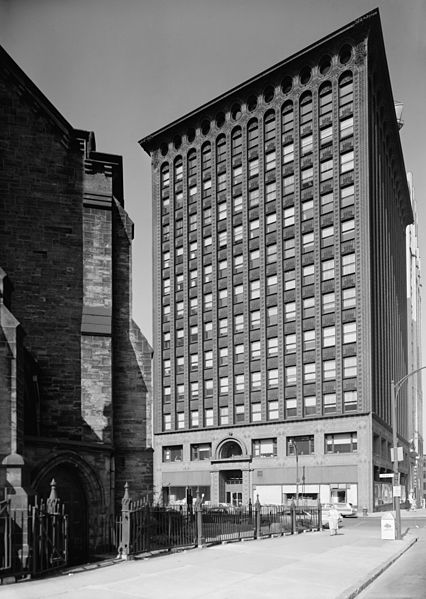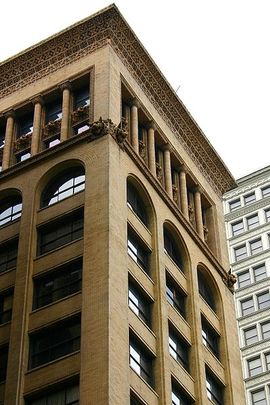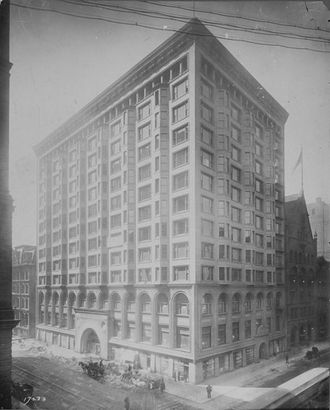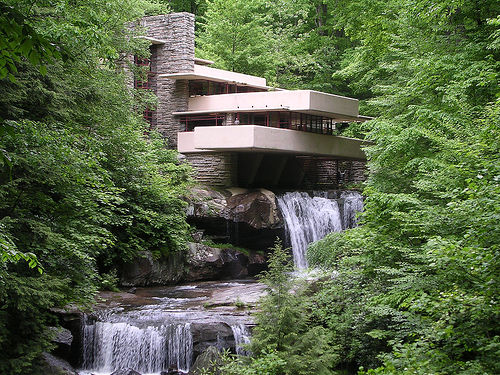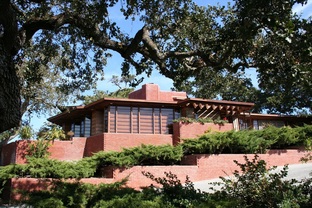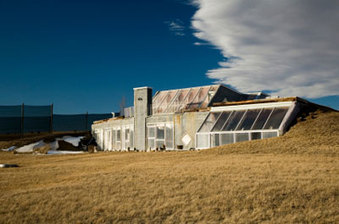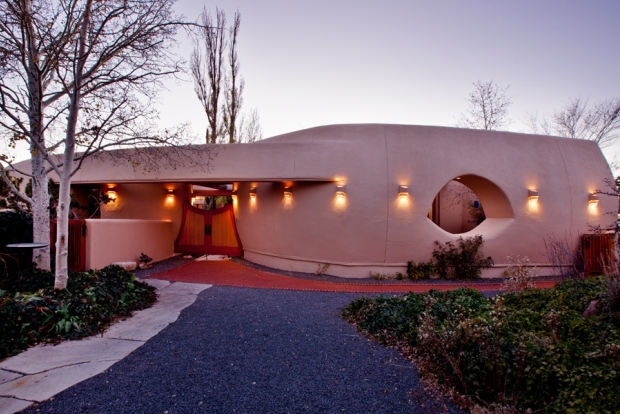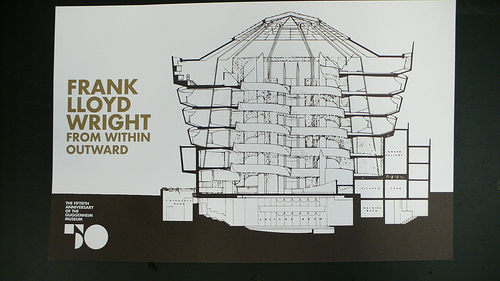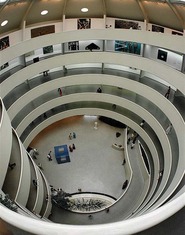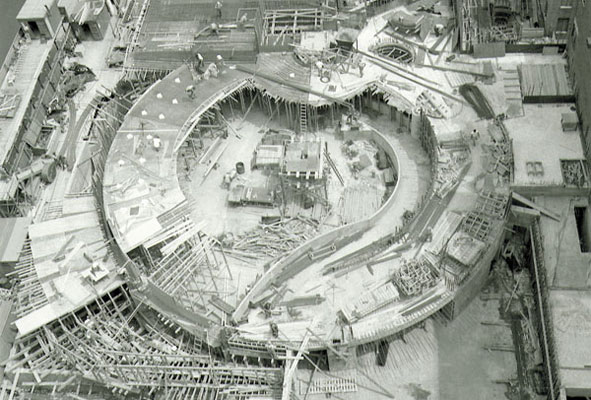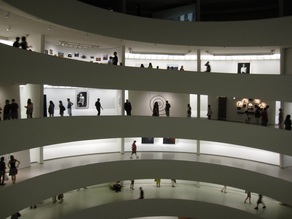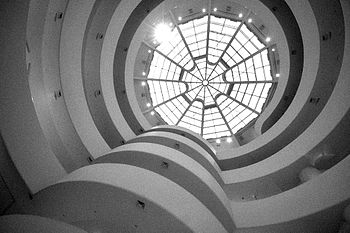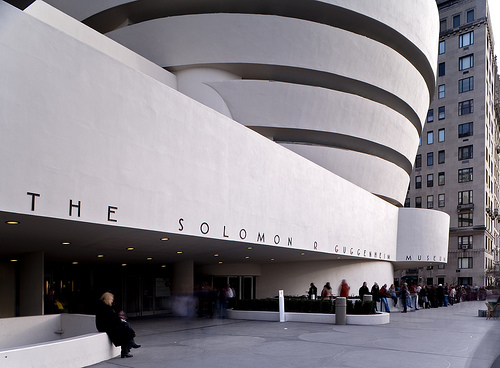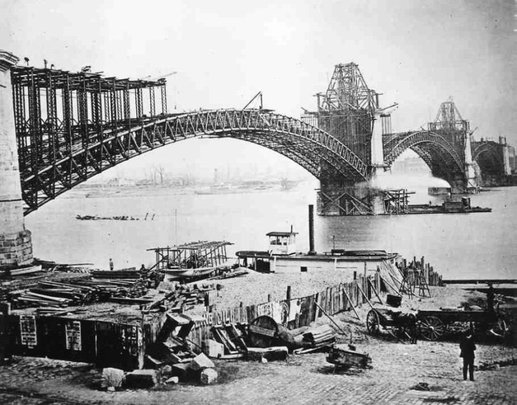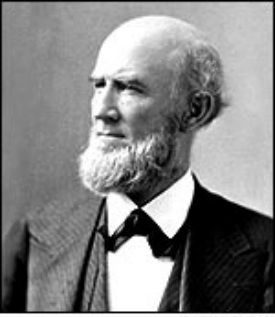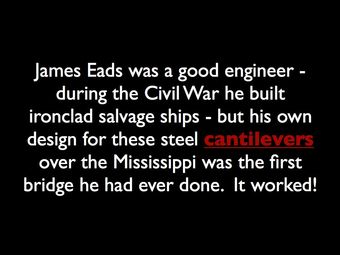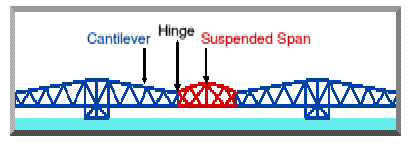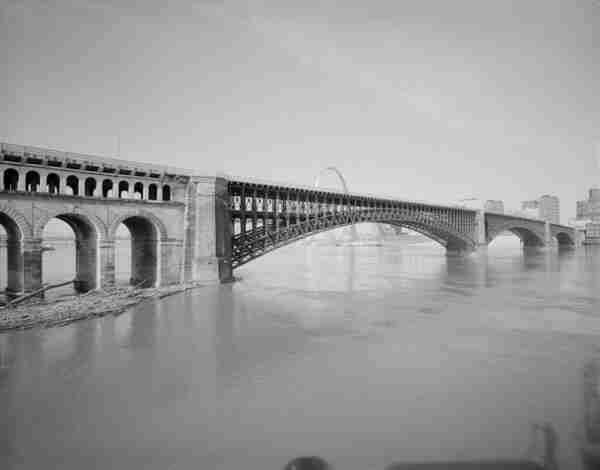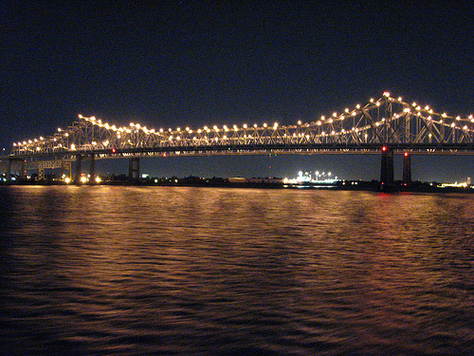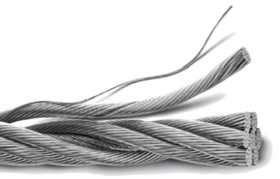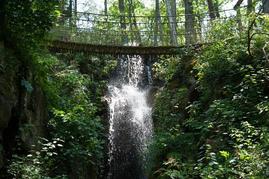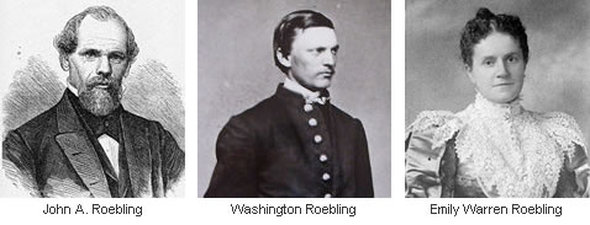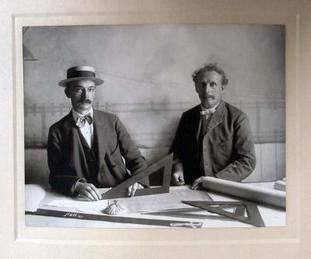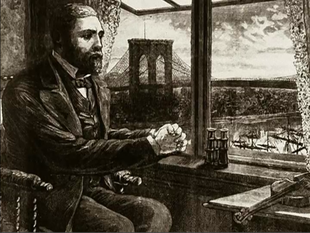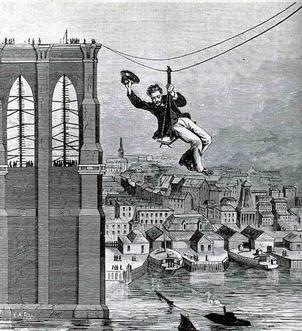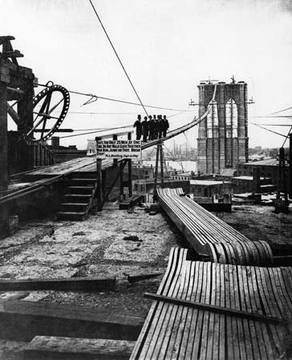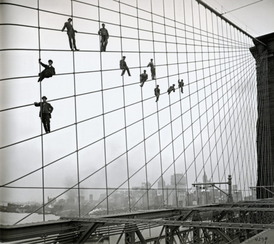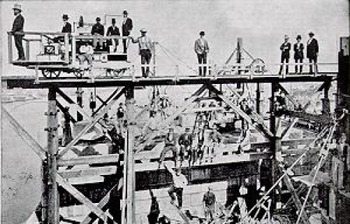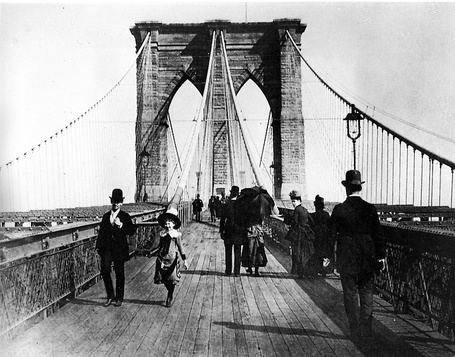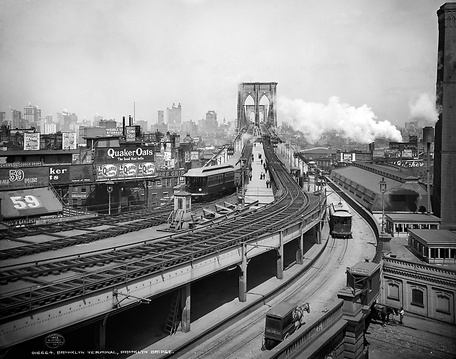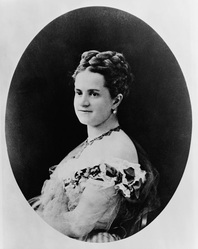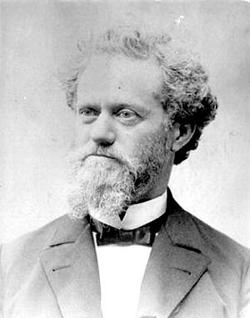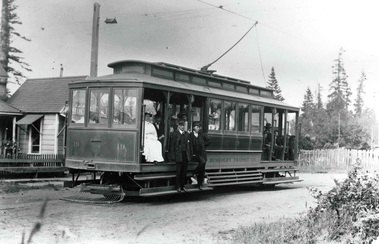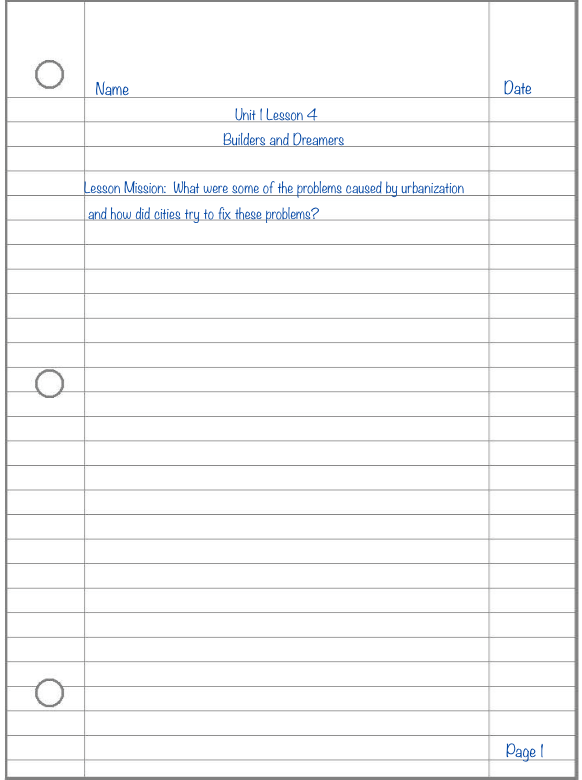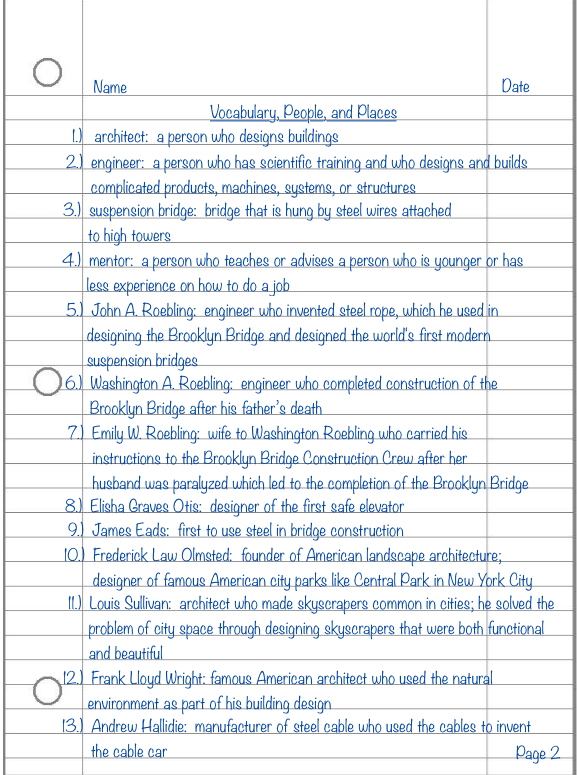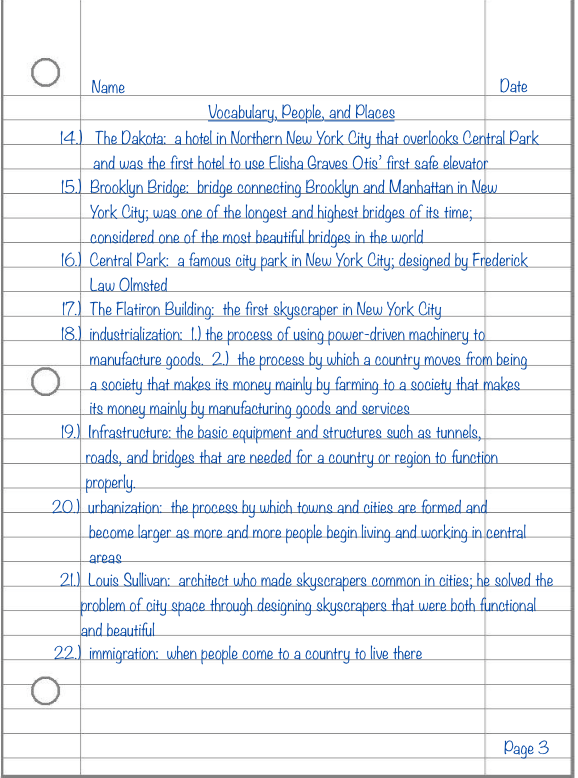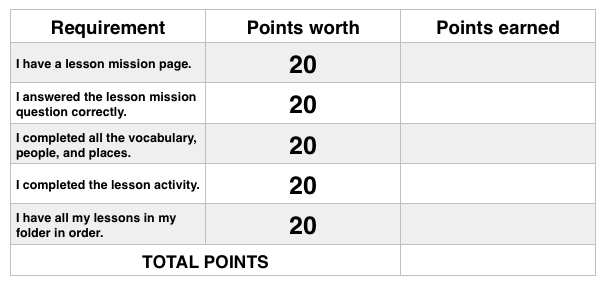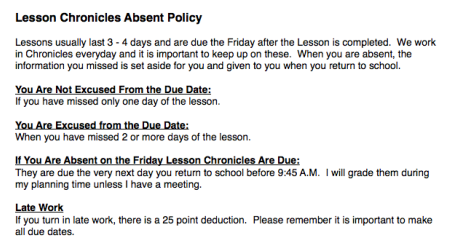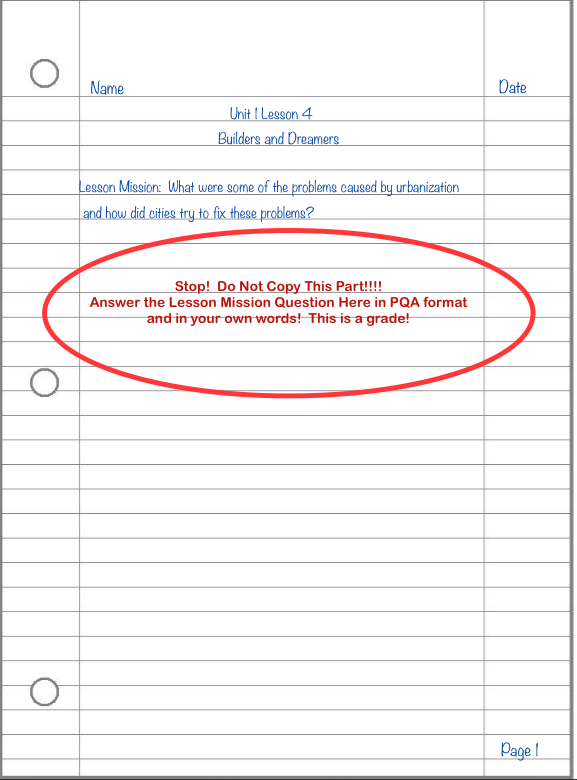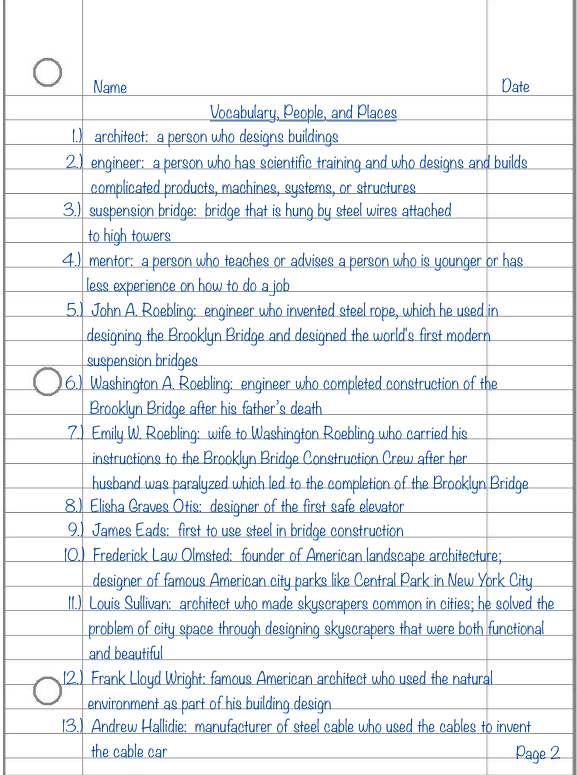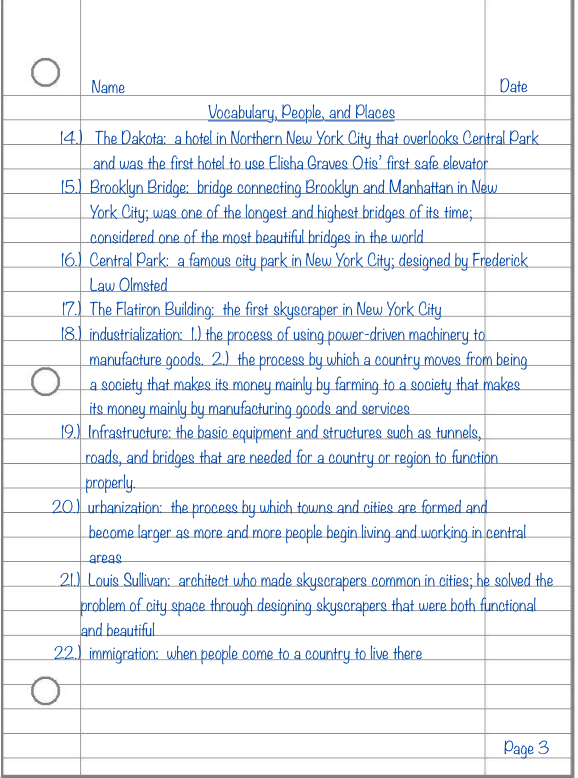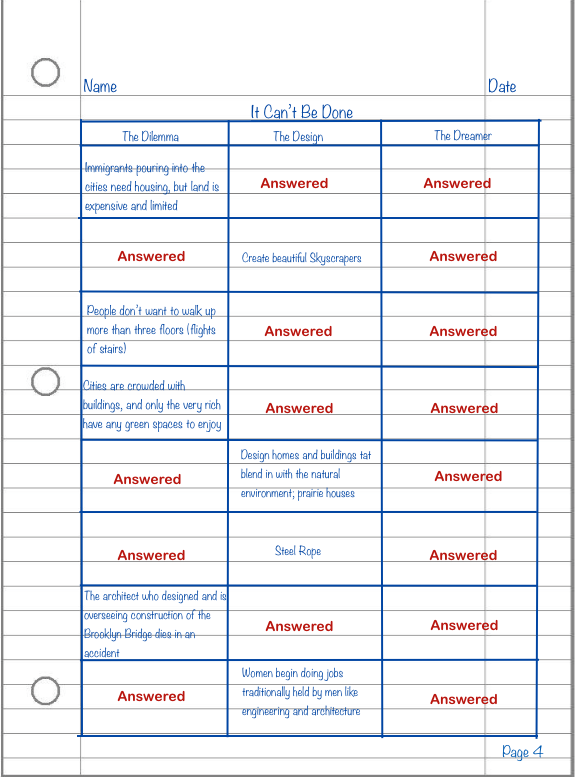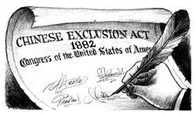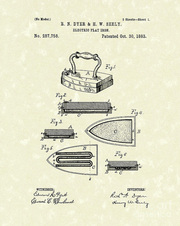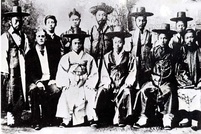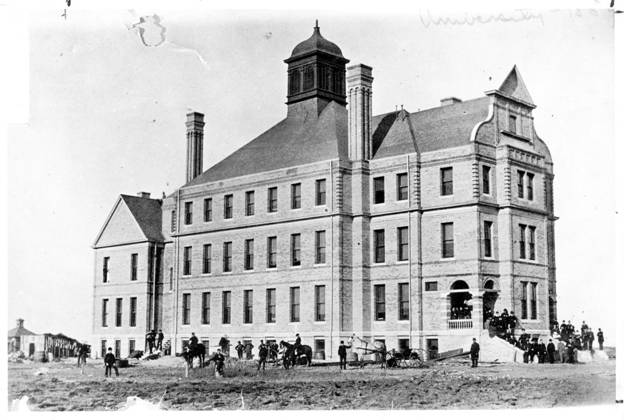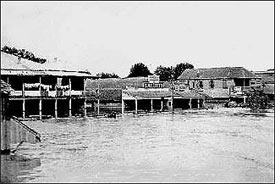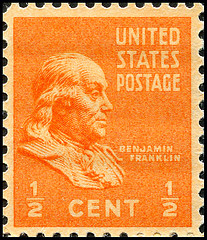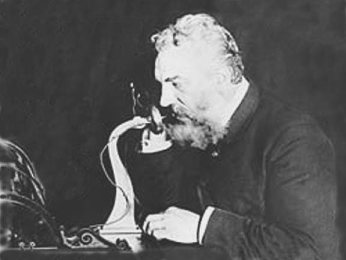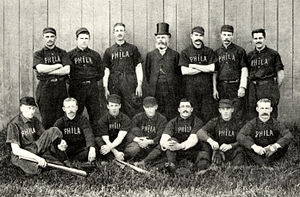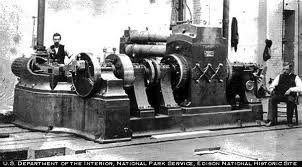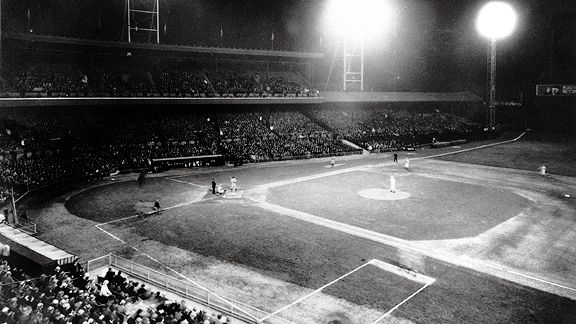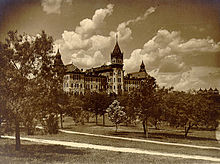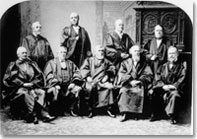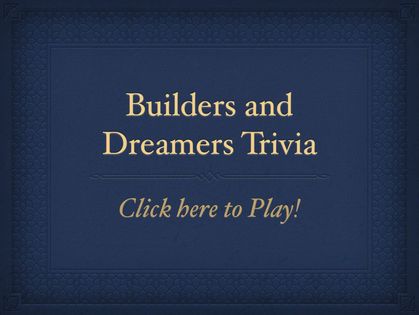Unit 1: An Age of Extremes
Topic 1: The Gilded Age
Topic 1: The Gilded Age
LESSON 4
~ BUILDERS AND DREAMERS ~
LESSON PURPOSE
Lesson Mission
|
DIRECTIONS: Remember, the Lesson Mission is what you, the student, will be able to do after the lesson is over. Begin today's Lesson Chronicles Entry by heading your paper with your name and the date and the Lesson Title. Write down today's essential question. Answering the essential question at the end of the lesson is your Lesson Mission!
|
Essential Question(s):
How were some of the problems caused by urbanization solved?
FOCUS ACTIVITY
Think - Team - Share
TEACHING ACTIVITY
Photographic Analysis
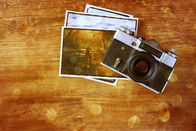
These bridges were built by by the Confederate and Union armies in the Civil War.
- What was the purpose of this bridge?
- How long do you think it would take to build a bridge like this?
- Why is this bridge appropriate for its function?
- Why is the bridge inappropriate for a big city?
This is a picture of the Brooklyn Bridge in New York City.
In 1869, New York City decided to build a bridge across the East River, connecting Brooklyn and Manhattan. It was called the Brooklyn Bridge. The Brooklyn Bridge was considered one of the most beautiful structures ever built.
- How is this bridge different than the Pontoon Bridges above?
In 1869, New York City decided to build a bridge across the East River, connecting Brooklyn and Manhattan. It was called the Brooklyn Bridge. The Brooklyn Bridge was considered one of the most beautiful structures ever built.
How are the New York Tenement Buildings and the Guaranty Building in the pictures below different?
The Guaranty Building was one of the very first skyscrapers. It was built by Louis Sullivan. We will be learning about Louis Sullivan today. What contribution do you predict Sullivan will make in fixing urbanization problems?
This picture is of a famous home. It is called Fallingwater, and was built by a man named Frank Lloyd Wright.
This house is one of the most famous private residences in the world. Frank Lloyd Wright is another famous architect we will learn about in this lesson’s reading. What do you think will be his contributions in solving urbanization problems?
- What are your impressions of this house? What do notice about it?
This house is one of the most famous private residences in the world. Frank Lloyd Wright is another famous architect we will learn about in this lesson’s reading. What do you think will be his contributions in solving urbanization problems?
WHOLE GROUP ACTIVITY
Guided Reading
Pre-Reading Non-Fiction Text
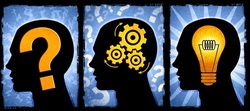
DIRECTIONS: Remember, accomplishing your lesson mission is your purpose for reading. To accomplish your mission, you must be able to answer the essential question(s). The reading is the primary way you will gain the information you need to answer the essential question. It is important to "pre-read" nonfiction text in order to gain a better understanding of what the reading will be about. Pre-reading requires you to identify key text structures in nonfiction texts. Pre-reading helps you to comprehend the reading better and make connections with what you are reading.
Recall the Key Text Structures in Non-Fiction Text:
1. Headers
2. Sub-headers
3. Bolded Words
4. Italicized Words
5. Pictures & Captions
6. Boxed off Information
7. Charts and Graphs
8. Maps
1. Headers
2. Sub-headers
3. Bolded Words
4. Italicized Words
5. Pictures & Captions
6. Boxed off Information
7. Charts and Graphs
8. Maps
Lesson Reading

DIRECTIONS: Now that you have a purpose for reading, and you have identified the key elements of the reading, we will take turns reading the passage below as a class.
As you read, if a certain part of the reading makes you think of a text to text, text to self, or text to world connection, write it down in your chronicles.
As you read, if a certain part of the reading makes you think of a text to text, text to self, or text to world connection, write it down in your chronicles.
Recall the text to text, text to self, and text to world strategy:
- Text to text references: When a certain word, phrase, or sentence reminds you of something else that you have read.
- Text to self references: When a certain word, phrase, or sentence reminds you of something about your own life.
- Text to world references: When a certain word, phrase, or sentence reminds you of a world issue or event
~ BUILDERS AND DREAMERS ~
One Invention Leads to Another |
TOOL BOX |
Loving Life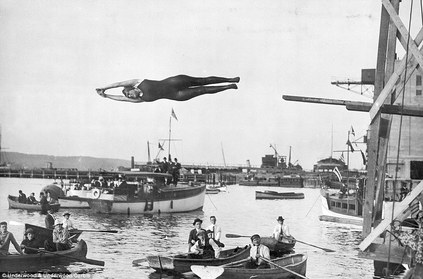 Fun in the Hudson River in NYC
Nineteenth - century Americans thought they lived in the most splendid era in all of history. You can understand why: all those new cities and inventions were mighty exciting. Even the traffic jams in Chicago and New York didn't seem too bad when you considered the things you could do and see in those great cities. The Elevator Man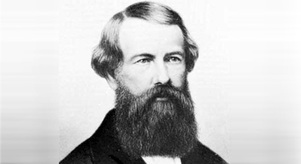 Elisha Graves Otis
Americans seemed to be doing things bigger and better than had ever been done before. Some men and women started thinking about building buildings taller than any built before. But there was no point in building really tall buildings because people were only willing to walk up four or maybe five flights of stairs. So that was as high as most buildings went until a Vermonter, Elisha Graves Otis, designed a safe elevator. Then, as they say, the sky was the limit. You could build tall buildings and people could ride up inside as high as the building went.
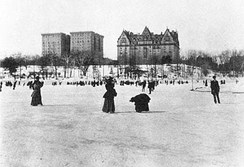 The Dakota Apartment Building is on the right. The people you see are in Central Park. The Dakota Apartment Building is on the right. The people you see are in Central Park.
In 1880, if you lived in the elegant Dakota apartment house in New York City, you could drive home in your carriage, back into the elevator, unhitch the horses, and you and your carriage would be lifted to your apartment door.
The Dakota got its name because when it was first built its location - at the corner of Central Park and 72nd Street - was so far north of the rest of the city that it might as well been in the Dakotas. It is still around, and still elegant. One of its 20th century tenants was John Lennon - of a popular rock band in the 1960s called the Beatles. He was also a political activist against the Vietnam War. He was killed in the building's entranceway.
Creating Nature?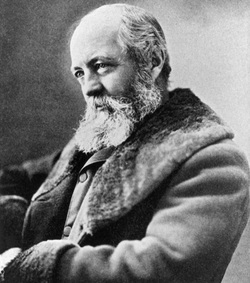 Frederick Law Olmsted
From your apartment at the Dakota you could look out your windows at beautiful new Central Park. America's first great city park was a marvel of the time. Most people, when they think of architecture, think of buildings. But land can be transformed by a designer as a sculptor transforms clay or an architect steel and stone. Frederick Law Olmsted, a great landscape architect, did just that with the scruffy land near the Dakota. He had lakes dug and hills built. He made formal areas with fountains, playgrounds, and concert shells. He created rugged and wild areas. Notice that word created. If you visit Central Park today, you might think nature made those rugged areas. Nature had a lot of help from Frederick Olmsted.
Central ParkOlmsted's ancestors had come to America on one of the earlier Puritan ships; they had been willing to leave their home in England to have freedom to practice their religion. Olmsted loved democracy and America's founding ideas. He believed that democratic cities should have large parks for recreation and quiet walking, open to all people. He thought a public park should be as handsome as a king's park. It took 20 years and 3,800 men to build Central Park, but when it was finished, New York had a park for the people that was lovelier than any king's park.
|
NEW VOCABULARY, PEOPLE, AND PLACES TO KNOW
architect: a person who designs buildings
engineer: a person who has scientific training and who designs and builds complicated products, machines, systems, or structures suspension bridge: bridge that is hung by steel wires attached to high towers mentor: a person who teaches or advises a person who is younger or has less experience on how to do a job John A. Roebling: engineer who invented steel rope, which he used in designing the Brooklyn Bridge and designed the world's first modern suspension bridges Washington A. Roebling: engineer who completed construction of the Brooklyn Bridge after his father’s death Emily W. Roebling: wife to Washington Roebling who carried his instructions to the Brooklyn Bridge Construction Crew after her husband was paralyzed which led to the completion of the Brooklyn Bridge Elisha Graves Otis: designer of the first safe elevator James Eads: first to use steel in bridge construction Frederick Law Olmsted: founder of American landscape architecture; designer of famous American city parks like Central Park in New York City Louis Sullivan: architect who made skyscrapers common in cities; he solved the problem of city space through designing skyscrapers that were both functional and beautiful Frank Lloyd Wright: famous American architect who used the natural environment as part of his building design Andrew Hallidie: manufacturer of steel cable who used the cables to invent the cable car The Dakota: a hotel in Northern New York City that overlooks Central Park and was the first hotel to use Elisha Graves Otis’ first safe elevator Brooklyn Bridge: bridge connecting Brooklyn and Manhattan in New York City; was one of the longest and highest bridges of its time; considered one of the most beautiful bridges in the world Central Park: a famous city park in New York City; designed by Frederick Law Olmsted The Flatiron Building: the first skyscraper in New York City OLD VOCABULARY, PEOPLE, AND PLACES TO KNOW
industrialization: 1.) the process of using power-driven machinery to manufacture goods. 2.) the process by which a country moves from being a society that makes its money mainly by farming to a society that makes its money mainly by manufacturing goods and services
Infrastructure: the basic equipment and structures such as tunnels, roads, and bridges that are needed for a country or region to function properly. urbanization: the process by which towns and cities are formed and become larger as more and more people begin living and working in central areas immigration: when people come to a country to live there innovation: a new idea or improvement on an old invention New York City: the largest city in the United States and one of the first cities to industrialize because of its location on the eastern seaboard |
Frederick Law Olmsted wrote, "we need institutions that shall more directly assist the poor...to elevate themselves." That may sound a bit patronizing but not if you really consider the idea.
Here is more: "Every laborer is a possible gentleman, not by the possession of money or fine clothes - but through the refining influence of intellectual and moral culture. Open wide, therefore, the doors of your libraries and picture galleries, all ye true Republicans!... Plant spacious parks in your cities, and unloose their gates as wide as the gate of morning to the whole people."
Here is more: "Every laborer is a possible gentleman, not by the possession of money or fine clothes - but through the refining influence of intellectual and moral culture. Open wide, therefore, the doors of your libraries and picture galleries, all ye true Republicans!... Plant spacious parks in your cities, and unloose their gates as wide as the gate of morning to the whole people."
The Sky's the Limit
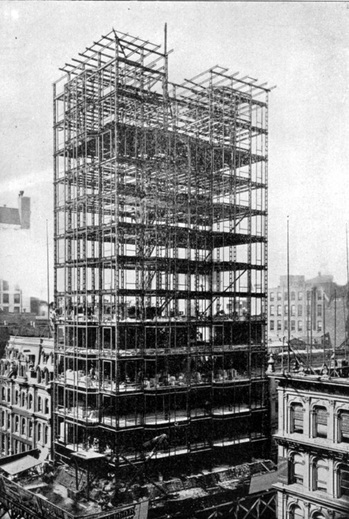
The steel frame of the Reliance Building in Chicago, IL
And now there were elevators, tall buildings seemed just the thing for America's new cities. But, if you think about it, there is a problem in building something very tall. The higher a building goes, the more it weighs.
So, if you wanted to build a tall building, you had to build its walls with stone or brick or something very strong to hold the weight. Tall buildings needed very thick bottom walls. When the first 16 story building was built in Chicago, the walls at its base were 15 feet thick. (Picture two six foot men and a three foot child lying down toes to head and you can see what 15 feet is like.)
Now this was an era of innovation. America was becoming the world's leading steel producer, so maybe it isn't surprising that some American architects came up with the idea of using steel as a frame for a building.
As you know, steel is very strong. A steel frame could hold all the weight of a tall building. The walls didn't have to hold any weight at all. Think about that. What did it mean? It meant - that thick walls weren't needed to support the building. Wall became just covering, like skin. The architect was free to use almost anything - even decorated metal or glass - as the skin of the building. Luckily, when this new idea came on the scene, America produced an architect that was a genius! He was able to take that technology and combine it with artistry. His name was Louis Sullivan.
So, if you wanted to build a tall building, you had to build its walls with stone or brick or something very strong to hold the weight. Tall buildings needed very thick bottom walls. When the first 16 story building was built in Chicago, the walls at its base were 15 feet thick. (Picture two six foot men and a three foot child lying down toes to head and you can see what 15 feet is like.)
Now this was an era of innovation. America was becoming the world's leading steel producer, so maybe it isn't surprising that some American architects came up with the idea of using steel as a frame for a building.
As you know, steel is very strong. A steel frame could hold all the weight of a tall building. The walls didn't have to hold any weight at all. Think about that. What did it mean? It meant - that thick walls weren't needed to support the building. Wall became just covering, like skin. The architect was free to use almost anything - even decorated metal or glass - as the skin of the building. Luckily, when this new idea came on the scene, America produced an architect that was a genius! He was able to take that technology and combine it with artistry. His name was Louis Sullivan.
Democracy in Art
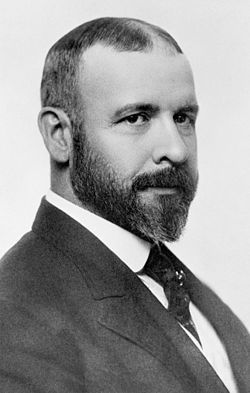 Louis Sullivan, perfecter of the American Skyscraper
Louis Sullivan, perfecter of the American Skyscraper
Louis Sullivan has been called the inventor of the skyscraper. That is not quite true. Sullivan didn't invent tall buildings. What he did do was build them beautifully. Sullivan loved nature and poetry. Like Frederick Olmsted, he too had strong feelings about democratic ideas. Sullivan tried to express his ideas in his architecture. And he did. His buildings are graceful and decorated with designs, shadows, and reflections.
Sullivan believed that the individual - each of us - is very important. It was an idea that he got from reading the words of people like Thomas Jefferson, Ralph Waldo Emerson, and Henry David Thoreau. Louis Sullivan built tall buildings that are comfortable and human in scale. They are American buildings - not copies of European palaces.
Sullivan believed that the individual - each of us - is very important. It was an idea that he got from reading the words of people like Thomas Jefferson, Ralph Waldo Emerson, and Henry David Thoreau. Louis Sullivan built tall buildings that are comfortable and human in scale. They are American buildings - not copies of European palaces.
The Student Surpasses the Teacher
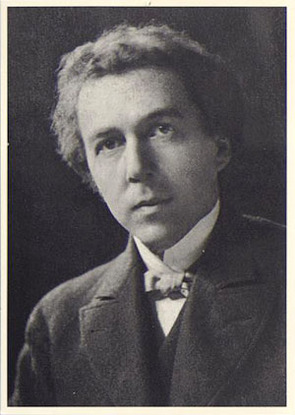
One day, a young Wisconsin-born architect named Frank Lloyd Wright came to work for Louis Sullivan. Frank Lloyd Wright became even more famous than his teacher.
Many people consider Wright to be one of the world's greatest architects. Like his mentor, Wright was concerned with that American idea of individual worth. His buildings were meant to make life more enjoyable for all who used them. They often seem a part of the landscape; that's because the architect thought a lot about the natural environment and the ways that people have always lived.
One of Wright's homes is built over a brook; another was inspired by an Indian pueblo. Some are called "prairie houses". How would you design a prairie house? What about the nature of the city - how would you design a city building? A New York Museum that Frank Lloyd Wright designed, the Guggenheim Museum, looks like a big round concrete tub. People take an elevator to the top of the tub and walk down a curvy ramp to the bottom, looking at paintings as they go.
Many people consider Wright to be one of the world's greatest architects. Like his mentor, Wright was concerned with that American idea of individual worth. His buildings were meant to make life more enjoyable for all who used them. They often seem a part of the landscape; that's because the architect thought a lot about the natural environment and the ways that people have always lived.
One of Wright's homes is built over a brook; another was inspired by an Indian pueblo. Some are called "prairie houses". How would you design a prairie house? What about the nature of the city - how would you design a city building? A New York Museum that Frank Lloyd Wright designed, the Guggenheim Museum, looks like a big round concrete tub. People take an elevator to the top of the tub and walk down a curvy ramp to the bottom, looking at paintings as they go.
Frank Lloyd Wright Homes
The Guggenheim Museum in New York City
Crossing New Bridges
|
Other things, besides buildings, needed to be built in America. Rivers needed to be crossed. But some rivers seemed way to wide for any bridge. A rickety wooded bridge had made it across the Mississippi River by hoping to an island in mid-river. Mostly though, if you wanted to cross that broad river, you had to wait for a ferry or find a boat. Then James Eads designed three great steel arches and sank them deep into the Mississippi River. They became the base for a bridge that crossed the mighty river near St. Louis, Missouri. Steel had never been used for a bridge before. No one knew if it would work. Sixteen men died building that bridge. After a tornado hit and the bridge survived - it was called an engineering marvel. When it was finished in 1874, you could take a train from the East Coast to the West Coast without ever touching water.
|
A Bridge Over Troubled Water
|
Steel is not only strong, it is flexible. A German immigrant, John Augustus Roebling, thought about that one day when he saw some worn out rope. He twisted thin steel wires together and made strong steel cable. That opened up all kinds of new ways to build things. Roebling came up with one of the best new ideas. He decided that a bridge could be suspended - which means hung - from steel cable attached to concrete and stone towers. Roebling designed the world's first modern suspension bridges. Actually, his bridges were similar in idea to the rope footbridges the Indians built in Central America 1,000 years ago. Except that Roebling built bridges strong enough to support railroad trains and cross mighty rivers. But when he suggested a bridge across New York's East River between Brooklyn and Manhattan, most people thought he had lost his mind.
|
A Bridge Challenge
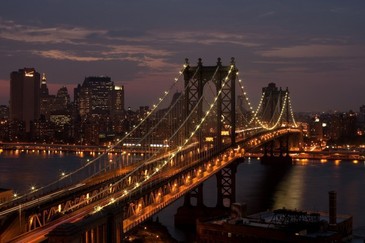
The Brooklyn Bridge Today
It would be the longest and highest bridge ever built anywhere in the world. It would have to withstand powerful winds and ocean tides. Experts said it was impossible. The stone towers needed to anchor the steel rope could not be placed on land; the distance from shore to shore was too great. The towers would have to be built in the river. No one was quite sure how that could be done. New construction methods would have to be developed.
Well, it was done. It was called the Brooklyn Bridge, and it took fourteen years to build. It demanded courage: from financiers who believed in the idea and raised the money (some were corrupt and made scandalous profits); from workmen who risked their lives; and from John Roebling, who lost his life after his toes were crushed in a construction accident and gangrene set in.
Well, it was done. It was called the Brooklyn Bridge, and it took fourteen years to build. It demanded courage: from financiers who believed in the idea and raised the money (some were corrupt and made scandalous profits); from workmen who risked their lives; and from John Roebling, who lost his life after his toes were crushed in a construction accident and gangrene set in.
A Dedicated Family
|
His son, 32 year old Washington Roebling took over. He was a Civil War hero and engineer. It was he that figured out that to build the gigantic stone towers, workers would have to go under water, into special chambers filled with compressed air. Roebling went right along with the laborers; then he was stricken with an illness that afflicts deeps sea divers. It is called the "bends" and it left him partially paralyzed. He was unable to move about and had to supervise from his bed, using binoculars to watch the workmen. His wife, Emily Roebling, went back and forth to the bridge with his daily instructions. When it was finally done, it was called a "Wonder of the World". Its towers were bigger than any other manmade structure except for the Egyptian Pyramids. The bridge was so high that ships could glide easily underneath it. Horse-drawn carriages, railroad trains, pedestrians, and an electric tram each had a special roadway on the Brooklyn Bridge.
|
Construction of the Brooklyn Bridge
The Completed Brooklyn Bridge in the Early 1900s
Bridge Party!
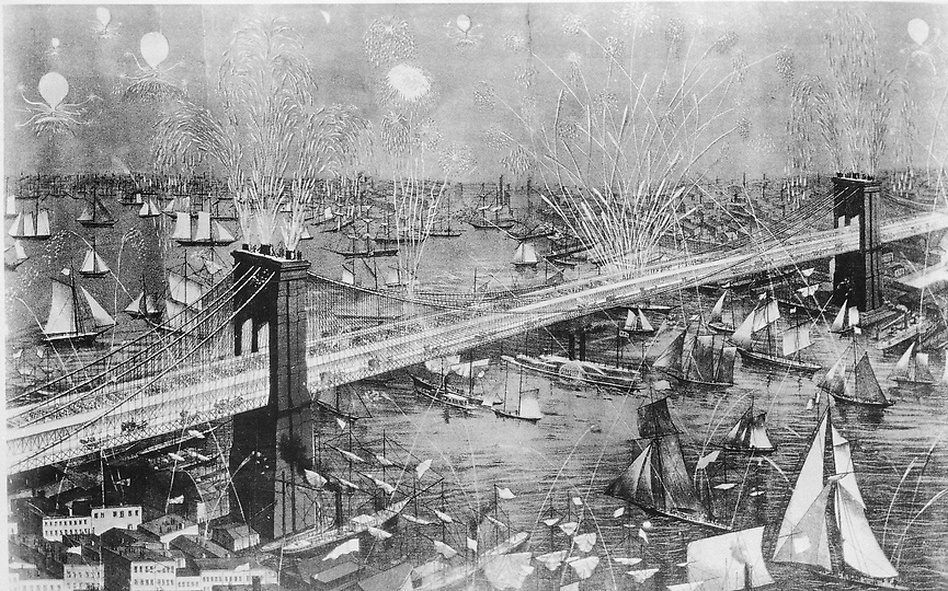
This was the scene at the official opening of New York's Brooklyn Bridge, May 24, 1883. (AP Photo/Museum of the City of New York)
When the bridge finally opened on May 24, 1883, 14 tons of fireworks were exploded in a show lasting 1 hour!
It was the first bridge lit by electricity. People came from all over just to see it. It towered over the buildings on both shores and linked the separate cities of Brooklyn and Manhattan into a united New York City. Americans felt that if they could build a wondrous bridge like this, they could do anything.
In 1883, New York City had its biggest party ever. It was even bigger than the one at the opening of the Erie Canal. Fireworks filled the sky. New York's governor, Grover Cleveland, said some words, but it was President Chester A. Arthur who cut the ribbon that officially opened the bridge. Then the president went to Washington Roebling's bedside to thank him on behalf of the nation.
The Brooklyn bridge was not only useful, it was gorgeous. Like Louis Sullivan and Frank Llloyd Wright, the Roeblings had used steel, stone, and concrete artistically.
For New Yorkers, the wait for the ferry was over.
In 1883, New York City had its biggest party ever. It was even bigger than the one at the opening of the Erie Canal. Fireworks filled the sky. New York's governor, Grover Cleveland, said some words, but it was President Chester A. Arthur who cut the ribbon that officially opened the bridge. Then the president went to Washington Roebling's bedside to thank him on behalf of the nation.
The Brooklyn bridge was not only useful, it was gorgeous. Like Louis Sullivan and Frank Llloyd Wright, the Roeblings had used steel, stone, and concrete artistically.
For New Yorkers, the wait for the ferry was over.
Afterword
There were many things that contributed to the successes of Sullivan, Wright, and the Roeblings. There were also other things that resulted from their successes. Check some of these out below.
When the Haters Stop Hatin'
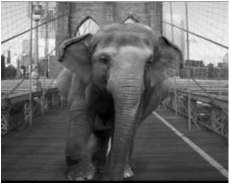
A few people wondered if the big bridge was really safe - but after circus man P.T. Barnum led a herd of elephants across it, there were no more doubters.
More About Emily!
Another Urban Problem Solved With Steel
|
Another problem faced in big cities was public transportation. Andrew Hallide helped to solve this problem for some large cities. Hallidie was an immigrant from Britain and manufacturer of steel cable. He used his steel wire ropes to invent the the cable car. Cable cars became a major mode of public transportation in many U.S. cities.
|
Record Vocabulary, People, and Places
After the reading, your Lesson Chronicles should look like the following pages.
SMALL GROUP ACTIVITY
The Amazing Race

For our Small Group Activity, we will, once again, play the Amazing Race. Remember, in the Amazing Race, you will work with your group to compete in a race the other groups in the class. The object of the game is to be the first team to correctly solve today's puzzle. Each team will have one minute to pick a writer, a runner, and 2 - 3 researchers. After one minute, each team will receive a puzzle sheet for the group. When I say go, you will race the other teams in the class to solve the puzzle by filling in the missing information on the puzzle using the reading.
The writer will write down the answers that the researchers find. When the group writer has completed the puzzle the group runner will bring the teams’ challenge sheet to me. I will review the challenge sheet. If it is incorrect, I will shake my head no and give you back the challenge sheet to correct - without any hints! If it is correct, I will tell you that you won the race.
When the winning team is announced, they will present the answers to the class. Everyone in the class will then copy the information into their Lesson Chronicles.
When the winning team is announced, they will present the answers to the class. Everyone in the class will then copy the information into their Lesson Chronicles.

After the race, I will give you the password to the answers. At that time, you will click on the icon on the right, type in the password, and the answers will appear.
INDIVIDUAL ACTIVITY
Answering the Essential Question
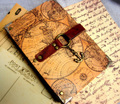
A Lesson Chronicles Activity is an individual activity where you prove that you accomplished the lesson mission. Lesson Chronicles require you to keep a notebook or journal with a table of contents. Each entry should be dated. First, you write the lesson mission. Then you prove you "can do" whatever the mission says by answering the essential question of the lesson in PQA format. Remember PQA format means "Put the Question in the Answer"
DIRECTIONS: Work by yourself to prove you have completed today's mission successfully by answering the essential question for today. Answer the question on the first page of your Lesson Chronicles under your Lesson Mission.
Recall our Class Motto:
Do Or Do Not. There Is No Try!
~ Yoda, From Star Wars Episode 5, The Empire Strikes Back ~
Do Or Do Not. There Is No Try!
~ Yoda, From Star Wars Episode 5, The Empire Strikes Back ~
Remember to follow the rubric and absent policy for completing Lesson Chronicles. You know what you have to do to make a 100/A+.
You choose to do it or not to do it. Don't allow yourself to give excuses! - Don't accept "I'll try!"
You choose to do it or not to do it. Don't allow yourself to give excuses! - Don't accept "I'll try!"
When you are done, your Lesson Chronicles for this lesson should look like the example below.
EXTENSION ACTIVITY
Learning More!
Extension Activity - Expand Your Learning with Movie Time!
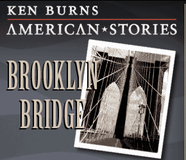
In today's extension activity, those students who completed and understood the lesson will extend their learning by watching a movie by Ken Burns called, The Brooklyn Bridge. This movie goes into detail about the building of the Brooklyn Bridge. You may also choose to learn more my exploring the Brooklyn Bridge Movie Website, investigating the timeline below, or playing the game below.
Click on the icon to the left to explore the website about the film. Or explore the information below about the Brooklyn Bridge. I will start the movie for you once I have given all groups their instructions.
Click on the icon to the left to explore the website about the film. Or explore the information below about the Brooklyn Bridge. I will start the movie for you once I have given all groups their instructions.
In the Year of the Bridge
Here are some things that happened in 1883, the year the Brooklyn Bridge opens:
Central Park Website
Check out Central Park by taking a virtual field trip. Click here to go to the:
Official Central Park Website.
Official Central Park Website.
Builders and Dreamers Trivia
Think you know everything about architecture during Industrialization? Prove it. Play Builders and Dreamers Trivia to test what you remember. Click on the icon below to play.
Detention Activity - Complete and Learn

This activity is designed to help you understand the importance of deadlines but also give you a chance to complete make up work. In this activity, you will complete Lesson Chronicles.
If you were absent, use this time to complete work. You will not have points deducted from your grade.
If you are not making up missed work, but instead chose to "DO NOT", you will finish your work now and you will be deducted 25 points for being late.
If you were absent, use this time to complete work. You will not have points deducted from your grade.
If you are not making up missed work, but instead chose to "DO NOT", you will finish your work now and you will be deducted 25 points for being late.
Help Activity - Clarify and Correct

This activity is designed to help you clarify misunderstandings and correct your Lesson Chronicles. In this activity, you will receive help on things you misunderstood during the lesson and you will correct your Lesson Chronicles.
HOMEWORK
Finish the Lesson and Family Time

Remember, you have homework every night in Social Studies. Your homework is to show your Lesson Chronicles to your family and tell them what you learned today. Not only will this give you quality time with your family but it will help you review for your unit test. Go over your lesson chronicles entry from today everyday to help you study for the Topic Quiz and Unit Test.
If you did not complete any assignments from today, they are homework. You never know when I am going to check portfolios, so make sure you are keeping up!
If you did not complete any assignments from today, they are homework. You never know when I am going to check portfolios, so make sure you are keeping up!
END OF THE UNIT 1 LESSON 4 MODULE
Congratulations, You've Completed this Lesson Module!
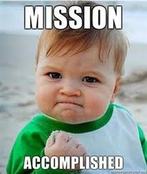
If you have finished your Lesson Chronicles, then you have finished the Lesson! Congratulations! Don't forget to check out the extension activity to learn more and make sure you study a little every night for the Unit Test!

